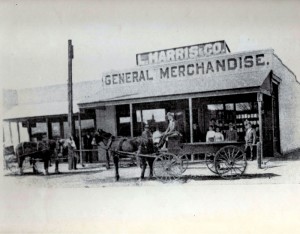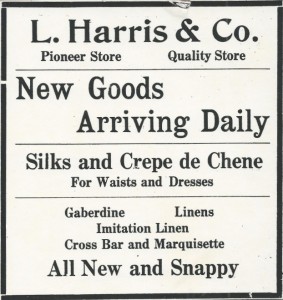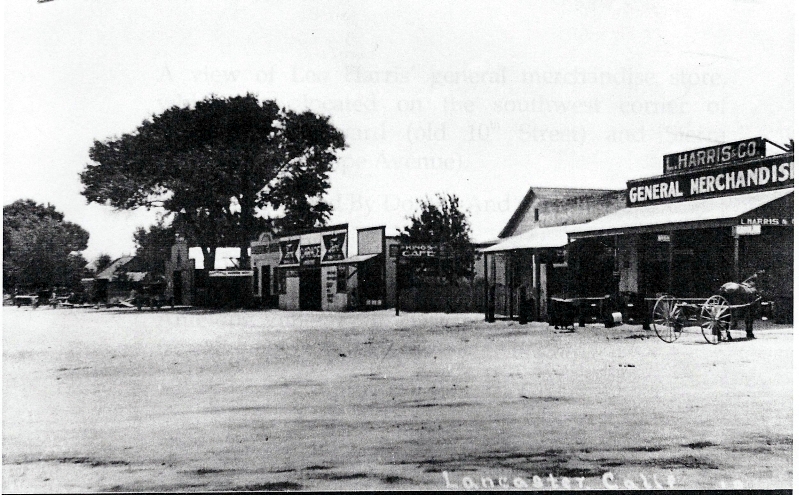Leo Harris
Values Codes I – E – L
One of the most respected and well-known families in the Antelope Valley from 1909 to the early 1920’s was that of Leo L. Harris. When the Antelope Valley Mall opened in 1990, it included an upscale Harris Store. The chain of stores was started by Leo Harris’s family in San Bernardino in 1905.
Leo Harris was born in a small Polish town (perhaps in Lautenberg) in the Prussian-controlled province of Posen.
He was one of seven children born to Morris and Johanna (Lesser) Hirschkowitz/Herschkowitz.
Leo’s older brother, Lewin Hirschkowitz, arrived in Los Angeles in 1853.
Lewin changed his name to Leopold Harris, as did each of his siblings as soon as they arrived, with the exception of the eldest brother, Lesser. [Click here for more on Leopold Harris]
According to census records, Leo Harris immigrated to the United States in 1887, (perhaps with his younger brother Herman), and was naturalized in 1894.
Along the way . . . .
Leo Harris first settled in Santa Ana, California, and worked with family members in The White House, a general mercantile store, which had been established by his brother, Herman Harris.
Antelope Valley
During the early 1890s, Leo’s brother, Phil Harris, entered the mercantile business in Bakersfield and traveled to mining camps in neighboring Tehachapi Mountains to sell his goods.
Leo Harris either went with his brother or arrived soon after (c. 1893/94) in the little community of West Greenwich/Tehachapi.
At age 17, Leo claims to have owned his own general store. He remained in the mercantile business here until 1909.
Leo was also involved in the Bank of Tehachapi.
In August 1906, the bank’s president was Dave Hirshfeld, cashier was Albert Ancker, and director was Leo Harris.
Lanchaster
In 1909, Leo Harris bought a general merchandise store from Paul Bachert at the best Lancaster business location:the southwest corner of old Antelope Avenue (present-day Sierra Highway) and 10th Street (Lancaster Boulevard), directly across the street from the Southern Pacific Railroad depot.
The general store sold a variety of items, which he usually obtained from his family in San Bernardino.
Through the years, Leo Harris expanded L. Harris & Co. General Merchandise Store, which was also home to the Lancaster Post Office from November 1, 1914 to February 1925.
In addition to non-Jews, the store also employed a number of Jewish residents, who comprised a very small community in greater Antelope Valley at the time. They included: Julian Steinberg, Harry Marx, J. Mendlewitz/Mendelowitz, and Murray Bleiberg.
Leo Harris, who was fluent in German and English, also hired young neighborhood boys, such as Glen Settle — later prominent valley historian — to wash the store windows and help deliver customer orders.
In addition to his mercantile business, Leo Harris had large real estate holdings — both residential and alfalfa fields — and took an active role in local freighting.
He also owned part of the Rogers-Gentry Gold Mine near Neenach, located in the western portion of the Antelope Valley.
In 1913, Harris helped to establish the Antelope Valley Implement Company in Lancaster, which was active in the implements and vehicle businesses.
There were very few automobiles in the Antelope Valley at the time, but Harris recognized their future importance.
While living in Tehachapi (1905), he and a friend, George Lovejoy, applied for a government patent for “A New and Useful Means for Lubricating Wheels,” particularly for plow usage.
Years later in Lancaster (July 1917), Harris applied for another patent, after inventing “New and Useful Improvements for Folding-Bed Attachments for Automobiles.”
Civic
In 1915, Leo Harris was also a director with the Lancaster-based Antelope Valley Bank.
Fraternal
Harris was an active community member of the Masons.
Community
There were no synagogues in the greater Antelope Valley in 1910. However, there lived in town Cornelius Epp, a 25-year-old boarder who spoke Yiddish, and whose occupation was listed as “Minister.”
As there were just a few Jewish residents living in downtown Lancaster at the time, services may have conducted by Cornelius Epp in private residences. Otherwise, Leo Harris would have had to travel to Bakersfield or Los Angeles.
Family
In 1909, Harris (32) married 23-year-old Esther H. Hirshfeld (Hirschfield) in Los Angeles.
Esther, who was born in Bakersfield in 1888, was the daughter of Marcus Hirshfeld and Minna Asher Hirshfeld.
Leo and Esther’s children included Helen Marion (1910-1983), who married Julius Jay Myers; Mildred Ruth (1912-1955), who married Emanuel Tanchuck (1909-1996); and Irving Harris (1914-1989), who married Shirley Jones.
Prominent Jewish families from different areas of Southern California would frequently visit Harris and his family. They included Albert Ancker, the Hirshfelds, the Ashers, and his brother, Dr. Lesser Hirschkowtiz, an early Jewish physician in Los Angeles.
The Harris family home was regularly the site of happy children’s events. They sometimes invited Helen Field, an early silent movie child actress and Lancaster resident, to perform at their parties.
Later Years
In 1925, Leo Harris and his family moved to Los Angeles.
Eventually, his store was absorbed by the Lancaster Department Store.
However, Leo’s son, Irving Harris, continued to live in the Antelope Valley for several more years.
Leo Harris died in 1951.
Esther Harris died in 1954.
Sources
- Hope Anker Gray, “Remarkable Harris Family of Southern California, Part 1,” Western States Jewish History 26/1.
- Hope Anker Gray, “Harris Family; Remarkable Harris Family of Southern California, Parts 2 & 3,” Western States Jewish History 26/2.
Norma Gurba-Kleit is curator of this Leo Harris exhibit.


